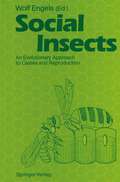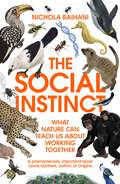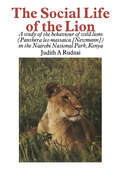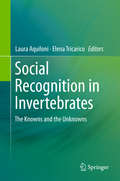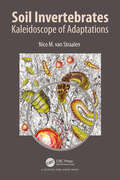- Table View
- List View
The Social Behavior of Older Animals
by Anne Innis DaggHow do young and old social animals view each other? Are aged animals perceived by others as weaker? Or wiser? What is the relationship between age and power among social animals?Taking a cue from Frans de Waal’s seminal work examining the lives of chimpanzees, Anne Innis Dagg in this pioneering study probes the lives of older mammals and birds. Synthesizing the available scientific research and anecdotal evidence, she explores how aging affects the lives and behavior of animals ranging from elk to elephants and gulls to gorillas, examining such topics as longevity; how others in a group view senior members in regard to leadership, wisdom, and teaching; mating success; interactions with mates and offspring; how aging affects dominance; changes in aggressive behavior and adaptability; and death and dying. At once instructive and compelling, this theme-spanning book reveals the complex nature of maturity in scores of social species and shows that animal behavior often displays the same diversity we find in ourselves.
Social Butterflies (Monographs in Population Biology #120)
by Henry S. HornAn ecologist's investigation of the social lives of butterfliesThroughout his career, Henry Horn took a unique approach to the study of butterflies. This book brings together his findings with recent advances in behavioral ecology to provide an incomparable look at the social lives of butterflies, illuminating for the first time the marvelously diverse range of butterfly behaviors across several species.Social Butterflies features in-depth studies of five sympatric species—the Plain Ringlet, the Eyed Brown, the Great Spangled Fritillary, the Viceroy, and the Pearly Eye—showing how their social interactions span much of the range of behaviors observed in vertebrates. Drawing on decades of his own keen observations in the field, Horn describes the natural history and behavioral peculiarities of each species and develops models to explain characteristic aspects of their behaviors. He then emphasizes key departures from these models to challenge the notion that butterflies are simply preconditioned to react to stimuli, showing how some make decisions by observing how other butterflies interact with the landscape and each other. Along the way, he sheds light on butterfly territoriality, mating tactics, vagrancy, feeding strategies, and more.Charting new directions for future research, Social Butterflies poses intriguing questions about the complex and sometimes mystifying social behaviors of these marvelous creatures, making it essential reading for lepidopterists, ecologists, and anyone interested in the social behaviors of invertebrate species.
Social Butterflies (Monographs in Population Biology #120)
by Henry S. HornAn ecologist's investigation of the social lives of butterfliesThroughout his career, Henry Horn took a unique approach to the study of butterflies. This book brings together his findings with recent advances in behavioral ecology to provide an incomparable look at the social lives of butterflies, illuminating for the first time the marvelously diverse range of butterfly behaviors across several species.Social Butterflies features in-depth studies of five sympatric species—the Plain Ringlet, the Eyed Brown, the Great Spangled Fritillary, the Viceroy, and the Pearly Eye—showing how their social interactions span much of the range of behaviors observed in vertebrates. Drawing on decades of his own keen observations in the field, Horn describes the natural history and behavioral peculiarities of each species and develops models to explain characteristic aspects of their behaviors. He then emphasizes key departures from these models to challenge the notion that butterflies are simply preconditioned to react to stimuli, showing how some make decisions by observing how other butterflies interact with the landscape and each other. Along the way, he sheds light on butterfly territoriality, mating tactics, vagrancy, feeding strategies, and more.Charting new directions for future research, Social Butterflies poses intriguing questions about the complex and sometimes mystifying social behaviors of these marvelous creatures, making it essential reading for lepidopterists, ecologists, and anyone interested in the social behaviors of invertebrate species.
Social Inequalities in Health in Nonhuman Primates: The Biology of the Gradient (Developments in Primatology: Progress and Prospects)
by Carol A. Shively Mark E. WilsonThis book provides a comprehensive look at nonhuman primate social inequalities as models for health differences associated with socioeconomic status in humans. The benefit of the socially-housed monkey model is that it provides the complexity of hierarchical structure and rank affiliation, i.e. both negative and positive aspects of social status. At the same time, nonhuman primates are more amenable to controlled experiments and more invasive studies that can be used in human beings to examine the effects of low status on brain development, neuroendocrine function, immunity, and eating behavior. Because all of these biological and behavioral substrates form the underpinnings of human illness, and are likely shared among primates, the nonhuman primate model can significantly advance our understanding of the best interventions in humans.
Social Insect Populations
by M. V. BrianSocial Insect Populations focuses on observations on the populations of social insects, including egg production, nesting characteristics, and food collection. The book first underscores the evolution of social life and organization and control of social insect populations. The text also ponders on the numbers and density of social insect populations, as well as methods of estimation, numbers in colonies, and density and biomass. Egg production, stationary populations, nest size, productivity, and survival are discussed. The manuscript discusses reproduction and brood periodicity of social insect populations. Discussions focus on reproduction by single and group of queens and reciprocity among bees, wasps, and ants. The text also examines nest sites and shelters, mating structures, and food collection of social insects. Discussions focus on food supply, intergeneric competition, predators and parasites, and population regulation among bees, wasps, termites, and ants. The book is a dependable reference for readers interested in the study of social insect populations.
Social Insects: An Evolutionary Approach to Castes and Reproduction
by A. Buschinger R. M. Crewe W. Engels K. Hartfelder C.G.J. van Honk V.L. Imperatriz-Fonseca C. D. Michener C. Noirot P. F. Röseler F. Ruttner A. Strambi H.H.W. VelthuisEvolution of Castes in Insects l BERNHARD RENSCH The evolution of organisms in the succession of generations has been primarilly achieved through the appearance of new hereditary variants with minor deviations along with the development of stable structures and functions. Harmful mutants were eradicated either immediately or in the subsequent generations through the process of natural selection while unharmful or advantageous ones usually survived. As this process continued, many new races and species developed which possessed structures and functions of a rational nature and which became increasingly independent from their environment. These evolutionary tendencies were also promoted through either geographical, ecological, physiological or genetical isolation of populations. In some phylogenetic lines, there occurred an increase in the number of cells due to additional cellular divisions in the morphogenesis of structures. This opened up the possibility for the development of the division of labour within cellular groups leading to more complicated and consequently more successful functions of tissues and organs. A further advancement in the adaptation of a species to its environment was made possible through specialization for certain functions of whole individuals or groups of individuals.
The Social Instinct: How Cooperation Shaped the World
by Nichola RaihaniWhy cooperate? This may be the most important scientific question we have ever, and will ever, face. The science of cooperation tells us not only how we got here, but also where we might end up. Cooperation explains how strands of DNA gave rise to modern-day nation states. It defines our extraordinary ecological success as well as many of the most surprising features of what make us human: not only why we live in families, why we have grandmothers and why women experience the menopause, but also why we become paranoid and jealous, and why we cheat. Nichola Raihani also introduces us to other species who, like us, live and work together. From the pied babblers of the Kalahari to the cleaner fish of the Great Barrier Reef, they happen to be some of the most fascinating and extraordinarily successful species on this planet. What do we have in common with these other species, and what is it that sets us apart?Written at a time of global pandemic, when the challenges and importance of cooperation have never been greater, The Social Instinct is an exhilarating, far-reaching and thought-provoking journey through all life on Earth, with profound insights into what makes us human and how our societies work.
Social Issues in Sustainable Fisheries Management (MARE Publication Series #9)
by Julie Urquhart Tim G. Acott David Symes Minghua ZhaoThis volume is an interdisciplinary mix of perspectives and studies on social issues in fisheries from a diverse range of case studies and research disciplines. The case is made regarding the dearth of attention to socio-cultural considerations which to date have been largely treated as an externality of fisheries policy. It will be valuable to researchers and decision makers interested in understanding the social dimension of fisheries and provides a timely and relevant compilation of research and analysis on some of the critical socio-cultural issues facing fisheries management and fishing communities today.
Social Learning: An Introduction to Mechanisms, Methods, and Models
by William Hoppitt Kevin N. LalandMany animals, including humans, acquire valuable skills and knowledge by copying others. Scientists refer to this as social learning. It is one of the most exciting and rapidly developing areas of behavioral research and sits at the interface of many academic disciplines, including biology, experimental psychology, economics, and cognitive neuroscience. Social Learning provides a comprehensive, practical guide to the research methods of this important emerging field. William Hoppitt and Kevin Laland define the mechanisms thought to underlie social learning and demonstrate how to distinguish them experimentally in the laboratory. They present techniques for detecting and quantifying social learning in nature, including statistical modeling of the spatial distribution of behavior traits. They also describe the latest theory and empirical findings on social learning strategies, and introduce readers to mathematical methods and models used in the study of cultural evolution. This book is an indispensable tool for researchers and an essential primer for students. Provides a comprehensive, practical guide to social learning research Combines theoretical and empirical approaches Describes techniques for the laboratory and the field Covers social learning mechanisms and strategies, statistical modeling techniques for field data, mathematical modeling of cultural evolution, and more
Social Learning: An Introduction to Mechanisms, Methods, and Models
by William Hoppitt Kevin N. LalandMany animals, including humans, acquire valuable skills and knowledge by copying others. Scientists refer to this as social learning. It is one of the most exciting and rapidly developing areas of behavioral research and sits at the interface of many academic disciplines, including biology, experimental psychology, economics, and cognitive neuroscience. Social Learning provides a comprehensive, practical guide to the research methods of this important emerging field. William Hoppitt and Kevin Laland define the mechanisms thought to underlie social learning and demonstrate how to distinguish them experimentally in the laboratory. They present techniques for detecting and quantifying social learning in nature, including statistical modeling of the spatial distribution of behavior traits. They also describe the latest theory and empirical findings on social learning strategies, and introduce readers to mathematical methods and models used in the study of cultural evolution. This book is an indispensable tool for researchers and an essential primer for students. Provides a comprehensive, practical guide to social learning research Combines theoretical and empirical approaches Describes techniques for the laboratory and the field Covers social learning mechanisms and strategies, statistical modeling techniques for field data, mathematical modeling of cultural evolution, and more
Social Learning In Animals: The Roots of Culture
by Bennett G. Galef Jr. Cecilia M. HeyesThe increasing realization among behaviorists and psychologists is that many animals learn by observation as members of social systems. Such settings contribute to the formation of culture. This book combines the knowledge of two groups of scientists with different backgrounds to establish a working consensus for future research. The book is divided into two major sections, with contributions by a well-known, international, and interdisciplinary team which integrates these growing areas of inquiry.Integrates the broad range of scientific approaches being used in the studies of social learning and imitation, and society and cultureProvides an introduction to this field of study as well as a starting point for the more experienced researcherChapters are succinct reviews of innovative discoveries and progress made during the past decadeIncludes statements of varied theoretical perspectives on controversial topicsAuthoritative contributions by an international team of leading researchers
The Social Life of the Lion: A study of the behaviour of wild lions (Panthera leo massaica [Newmann]) in the Nairobi National Park, Kenya
by J.A. RudnaiTHE HABITAT Nairobi National Park lies to the south-southeast of the capital of Kenya, Nairobi, where the Athi Plains meet the Eastern escarpment of the Rift Valley. These plains form part of the semi-arid highland plateau lying between the coast and the Rift Valley. Both the city itself, and the Park bordering it, are a meeting place of two generally distinct types of landscape and climate. While to the east-southeast are semi-arid plains with grasslands and scattered trees, the western-north western parts are higher, hilly, cooler, more humid and support lush forests. The combination of latitude-a little over one degree south of the Equator -and altitude-average of 1600 m. (5000-5500 ft.) -combine to give Nairobi a most equable climate where the temperature varies during the year between about 11 degrees and 27 degrees centigrade (mean minimum and mean maximum for eight years). However, considerable changes are usually experienced within each day and a rise from 14 degrees C at 0600 hours to 22 degrees at 1100 hours is not unusual. Nairobi Park has a unique concentration of wild animals living in their natural habitat less than 10 km. from the centre of a modern city of half a million people. The only interference with the natural course of events in the Park is that normally required for the proper management of a game park, such as maintenance of roads and dams, and, in this particular case, partial fencing towards the city.
Social Psychology of Aggression: From Individual Behavior to Social Interaction (Springer Series in Social Psychology)
by Amélie MummendeySocial Recognition in Invertebrates: The Knowns and the Unknowns
by Laura Aquiloni Elena TricaricoThis book uses a wide range of case studies from different invertebrate taxa to describe the numerous forms of social recognition occurring in this large group of animals and traces the evolution of this cognitive ability. The authors provide several examples of direct (i.e. the target of recognition is a conspecific) and indirect recognition (i.e. recognition of a reliable proxy rather than an individual, such as a den or a substrate) and discuss cases of familiar recognition (i.e. an animal remembers a conspecific but cannot tell what class it comes from or recognize its identity). Class-level recognition (i.e. an animal assigns a conspecific to an appropriate class of animals), and true individual recognition (i.e. an animal both identifies and recognizes a conspecific on an individual basis) are also addressed.
Social Strategies of Carnivorous Mammalian Predators: Hunting and Surviving as Families (Fascinating Life Sciences)
by Mridula Srinivasan Bernd WürsigThe book offers a comparative look at the social strategies of five carnivorous social predators (four terrestrial and one marine) that make them successful hunting units. The focus is on mammalian predators hunting (largely) mammalian prey. Each chapter (with separate authors) devoted to a particular species, explores the versatile hunting techniques and social dynamics of these top predators as they attempt to survive, defend, and reproduce in challenging habitats. Each chapter also delves into how the social fabric and ecology of each species influence their ability to deal with natural and man-made threats and shifting baselines.
Social Wellbeing and the Values of Small-scale Fisheries (MARE Publication Series #17)
by Derek S. Johnson Tim G. Acott Natasha Stacey Julie UrquhartThis book advances discussions of values in fisheries by showing the rich theoretical insights and connections possible when value is grounded in a multi-dimensional social well being approach. Questions of value have long been a central, if often unacknowledged, concern in maritime studies and in research on fisheries. Social scientists have looked at changing perceptions of value as coastal regions and fisheries have industrialized, economic interconnections have deepened, ecosystems have been depleted, shifts in population have occurred, and governance arrangements have been transformed. With a focus on the diverse ways in which small-scale fisheries are valued, the contributions to this volume address these and other themes through cases from numerous countries in Asia, Europe, and Latin America. “This volume provides a timely contribution to the development of new approaches that seek to capture the complexity of how fisheries can be understood beyond standard mono-dimensional, and often economic, interpretations. Each chapter makes a clear and stand-alone contribution to conceptual and methodological advancement, and collectively these works cover a wide range of frameworks and schools of thought.”Dr Sarah Coulthard, Senior Lecturer in International Development, Northumbria University, UK“The list of contributing authors [is] impressive and covers a wide geographical range of illustrative examples, [which] helps to demonstrate the global value of small-scale fisheries.” Professor J. Allister McGregor, Professor in Political Economy, the University of Sheffield, UK
Sociality: The Behaviour of Group-Living Animals
by Ashley Ward Mike WebsterThe last decade has seen a surge of interest among biologists in a range of social animal phenomena, including collective behaviour and social networks. In ‘Animal Social Behaviour’, authors Ashley Ward and Michael Webster integrate the most up-to-date empirical and theoretical research to provide a new synthesis of the field, which is aimed at fellow researchers and postgraduate students on the topic.
Sociality in Bats
by Jorge OrtegaThis book provides new insights into the social behavior of bats - one of the most fascinating topics currently being pursued by researchers. After an introduction reviewing the history of research in bat behavioral ecology, it covers three major themes: bat sociality per se (Part I), bat communication (Part II), and ecological aspects (Part III). Part I offers a concise overview of the social organization and systems of bats, introducing readers to the complexity and dynamics of group structures. Part II is devoted to the innovative field of social communication, focusing on bat songs, dialects and calls. Part III discusses the influence of the environment on bat behavior, particularly with regard to roosting and foraging. This book addresses the needs of researchers working in behavioral sciences, evolution and ecology.
Sociobiology of Caviomorph Rodents: An Integrative Approach
by Luis A. Ebensperger Loren D. HayesFully integrative approach to the socibiology of caviomorph rodents Brings together research on social systems with that on epigenetic, neurendocrine and developmental mechanisms of social behavior Describes the social systems of many previously understudied caviomorph species, identifying the fitness costs and benefits of social living in current day populations as well as quantified evolutionary patterns or trends Highlights potential parallels and differences with other animal models
Sociobiology of Caviomorph Rodents: An Integrative Approach
by Luis A. Ebensperger Loren D. HayesFully integrative approach to the socibiology of caviomorph rodents Brings together research on social systems with that on epigenetic, neurendocrine and developmental mechanisms of social behavior Describes the social systems of many previously understudied caviomorph species, identifying the fitness costs and benefits of social living in current day populations as well as quantified evolutionary patterns or trends Highlights potential parallels and differences with other animal models
Sociophysics: A Physicist's Modeling of Psycho-political Phenomena (Understanding Complex Systems)
by Serge GalamDo humans behave much like atoms? Sociophysics, which uses tools and concepts from the physics of disordered matter to describe some aspects of social and political behavior, answers in the affirmative. But advocating the use of models from the physical sciences to understand human behavior could be perceived as tantamount to dismissing the existence of human free will and also enabling those seeking manipulative skills . This thought-provoking book argues it is just the contrary.Indeed, future developments and evaluation will either show sociophysics to be inadequate, thus supporting the hypothesis that people can primarily be considered to be free agents, or valid, thus opening the path to a radically different vision of society and personal responsibility. This book attempts to explain why and how humans behave much like atoms, at least in some aspects of their collective lives, and then proposes how this knowledge can serve as a unique key to a dramatic leap forwards in achieving more social freedom in the real world. At heart, sociophysics and this book are about better comprehending the richness and potential of our social interaction, and so distancing ourselves from inanimate atoms.
Sodium and Water Homeostasis: Comparative, Evolutionary and Genetic Models (Physiology in Health and Disease)
by Kelly Anne Hyndman Thomas L. PannabeckerThis book presents cutting edge methods that provide insights into the pathways by which salt and water traverse cell membranes and flow in an orchestrated fashion amongst the many compartments of the body. It focuses on a number of molecular, cellular and whole animal studies that involve multiple physiological systems and shows how the internal milieu is regulated by multifactorial gene regulation, molecular signaling, and cell and organ architecture.Topics covered include: water channels, the urinary concentrating mechanism, angiotensin, the endothelin system, miRNAs and MicroRNA in osmoregulation, desert-adapted mammals, the giraffe kidney, mosquito Malpighian tubules, and circadian rhythms. The book highlights how different approaches to explaining the same physiological processes greatly increase our understanding of these fundamental processes. Greater integration of comparative, evolutionary and genetic animal models in basic science and medical science will improve our overall grasp of the mechanisms of sodium and water balance.
Soil Colloids and Their Associations in Aggregates (Nato Science Series B: #214)
by Marcel F. De Boodt Michael H. B. Hayes Adrien HerbillonS. Henin Versailles, France It was a pleasure for me to take part in the NATO Advanced Study Workshop for studies of 'Soil Colloids and their Associations in Soil Aggregates'. The meeting provided me with a welcome opportunity to renew acquaintances with respected colleagues in the various fields of Soil Science, to listen to their presentations, and be involved in discussions which were at the frontiers of the science which deals with the structures and the associations of the soil colloidal constituents. In my view the rapid advances in Soil Science, and the great benefits to agriculture from these, have their origins in the emerging understanding of the structures and the associations of the different soil colloids. It is clear that much research is still needed before the molecular details of the most important of the structures and of the interactions are fully understood. The associations between the soil colloids, and the manner in which they bind to or hold the other constituents of soils in aggregates is fundamental to soil fertility. and the Modem intensive agriculture leads to the degradation of soil structure subsequent loss through erosion of a resource that is vital for the production of food. This degradation is considered to result primarily from the biological oxidation of the indigenous soil organic matter, and from the failure to return to the soil sufficient organic residues to compensate for such losses.
Soil Invertebrates: Kaleidoscope of Adaptations
by Nico M. van StraalenSoil invertebrates make up diverse communities living in soil pores and on the soil surface, digging burrows and tunnels, processing organic matter and interacting with microbes. Soil is also a habitat of growing concern as many human activities cause soil degradation. This book documents the evolutionary history of soil invertebrates and their multitude of adaptations. Soil invertebrates live in a twilight zone: some have gone down to seek stability, constancy and rest, others have gone up and faced environmental variation, heat, cold and activity. And it all happens in a few decimetres, millimetres sometimes. Check out the wonderful life below ground in this book.
Soil Invertebrates: Kaleidoscope of Adaptations
by Nico M. van StraalenSoil invertebrates make up diverse communities living in soil pores and on the soil surface, digging burrows and tunnels, processing organic matter and interacting with microbes. Soil is also a habitat of growing concern as many human activities cause soil degradation. This book documents the evolutionary history of soil invertebrates and their multitude of adaptations. Soil invertebrates live in a twilight zone: some have gone down to seek stability, constancy and rest, others have gone up and faced environmental variation, heat, cold and activity. And it all happens in a few decimetres, millimetres sometimes. Check out the wonderful life below ground in this book.




